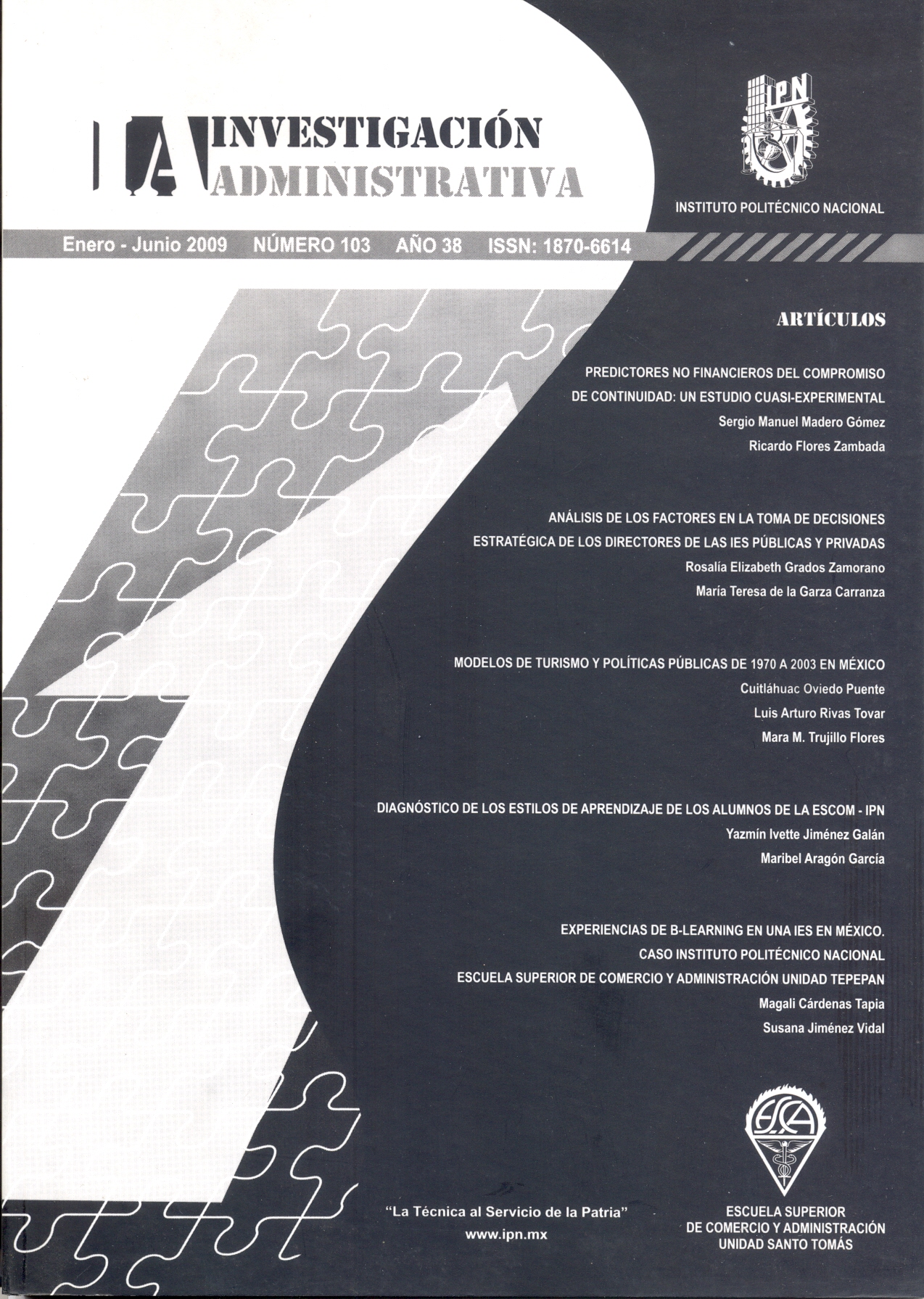TOURISM MODELS AND PUBLIC POLICIES FROM 1970 TO 2003 IN MEXICO
Main Article Content
Abstract
This work presents an analysis of the policies in the matter of tourism in Mexico since 1973 to 2003 and the three first years of Fox management. As a result of this has been demonstrates that in Mexico has not a state policy and that the strategy has changed every six years. Mexican model is not related to others models reported in literature. The policy has pretended to be planned nevertheless, actually the tourist policy has fortified to the transnational oligopolies and even though the tourist activity represents 8% of the GIP and it is within the principal's economic activities, the average wages are, after the agricultural sector and the construction, lowest at national level.
Article Details

This work is licensed under a Creative Commons Attribution-NonCommercial 4.0 International License.
References
Aradhyula, S. y Tronstad, R. (2003). Does Tourism Promote Cross-border trade? EU:
American Agricultural Economics Association
Aguilar, J. (1996). Tourism and Cultural Displays: Inventing Traditions for Whom? Journal of American Folklore, 102:131-146.
Bustamante, J. (2008). Turismo europeo en el horizonte 2020. Conferencia Observatorio de Turismo, Málaga, España, feb. 2008.
Butler, R. W. (1990). Alternative tourism: Pious hope or Trojan horse? Journal of Travel Research (3):40-45.
Cabrero, M. E. (2006). La nueva gestión pública y su teoría de la organización: ¿Son argumentos antiliberales? Justicia y equidad organizacionales. Gestión y Política Pública, CIDE, México, vol. XIV, núm. 3, segundo semestre. Coautoría con David Arellano, 2005
Douglas, N.A., Douglas, N. y Derrett, R. (2001) Special Interest Tourism. Brisbane: Wiley.
Doxey, K. (1975). Fases por las que atraviesan las actitudes de los residentes hacia los turistas. Nueva York: Oxford University.
Doxey, K. (1975). Fases por las que atraviesan las actitudes de los residentes hacia los turistas. Nueva York: Oxford University: 27
Gascehn, D. (2000). Trouble in Paradise. EU: California State University.
Gibson, D. (2006). Outer Space Tourism Public Relations Purpose. Practices and Problems. EU: University of New Mexico
Gouvea, R. (2004). Managing the Ecotourism Industry in Latin America: Challenges and Opportunities. EU: University of New Mexico.
Gouvea, R. (2004). Managing the Ecotourism Industry in Latin America: Challenges and Opportunities. EU: University of New Mexico.Greathouse, A. (2005). Tourism and Policy in Preserving Minority Languages and Culture. The Cuetzalan experience. México: The Policy Studies Association.
Higgings, F. (2008). Justice Tourism and Alternative Journal of Sustainable Tourism, 16 (3): 345-364
Jiménez, A. (2005). Desarrollo Turístico y Sustentabilidad: el caso de México. México: Porrua
Lanfant, M. F., Allcock, J. B. y Bruner, E. M. (1995). International Tourism. Identity and Change, Londres: Sage.
Mowforth, M. y Munt, I. (2003). Tourism and Sustainability: Development and New Tourism in the Third World. 2a. ed. Londres: Routledge.
Poder Ejecutivo Federal. (2001). Programa Nacional de Turismo 2001-2006. México: Sectur.
Poder Ejecutivo Federal. (2003a). Compendio
Estadístico del Turismo en México 2002.
México: Sectur.
Poder Ejecutivo Federal. (2003b). Compendio
Estadístico del Turismo en México 2002.
Sectur.
Poder Ejecutivo Federal. (2003c). Compendio
Estadístico del Turismo en México 2002.
Sectur
Poder Ejecutivo Federal. (2003d) Compendio
Estadístico del Turismo en México 2002.
Sectur.
Poder Ejecutivo Federal. (2002b). Datos 1988 estadísticas básicas de la actividad turística 1991. Sectur. Datos 1994, Compendio Estadístico del Turismo en México 2002.
Sectur.
Poder Ejecutivo Federal. (2001). Programa Nacional de Turismo 2001-2006. El turismo: la fuerza que nos une. México: Sectur.
Poder Ejecutivo Federal. (1994). Diarios Oficiales de la Federación. 31 dediciembrede 1988 y 30 de diciembre de 1993, respectivamente. México: Sectur.
Poder Ejecutivo Federal. (1992a). La Actividad Turística 1991. México: Sectur.
Poder Ejecutivo Federal. (1992b). Ley Federal de Turismo. Diario Oficial de la Federación.
Poder Ejecutivo Federal. (1992c). Estadísticas Básicas de la Actividad Turística 1991. México: Sectu
Poder Ejecutivo Federal. (1992d). Estadísticas Básicas de la Actividad Turística 1992. México: Sectur.
Poder Ejecutivo Federal. (1992e). Estadísticas Básicas de la Actividad Turística 1991. México: Sectur: 234.
Poder Ejecutivo Federal. (1992g). Ley Federal de Turismo. DOF, 31 de diciembre de 1992
Poder Ejecutivo Federal. (1988). Presupuesto de Egresos de la Federación 1983 y 1988. Diarios Oficiales de la Federación. 31 de diciembre de 1982 y 31 de diciembre de 1987, respectivamente.
Poder Ejecutivo Federal. (1980b). Presupuesto de Egreso de la Federación 1976 y 1980. Diarios Oficiales de la Federación. 31 de diciembre de 1976 y 31 de diciembre de 1980,224
Plog, S. (1980). Village Autonomy in the American Southwest: An Evaluation of the Evidence. En Robert E. Fry (ed.). Models and Methods in regional exchange. SAA paper No. 1, Society for American Archaeology,
Washington, 135-146.
Rivas, T. L. A. (2008). Macro tendencias del turismo. Una evaluación de la política turística en México. Conferencia magistral en el X Foro de Alcosta la Paz, BC, México, 28 de agosto de
Smith, M. (1989). Modelos turísticos locales. Análisis comparado de dos destinos de la Costa Blanca. Investigaciones Geográficas, 21:35-57.
Smith, M. y Duffy, R. (2003). The Ethics of Tourism Development. Londres: Routle
Smith, V. L. (1989). Hosts and Guests. The Anthropology of Tourism, Philadelphia:
University of Pennsylvania Press.
Smith, V. L. y Eadington, W. R. E. (Eds.) (1992). Tourism Alternatives: Potentials and Problems in the Development of Tourism, Chichester, Reino Unido: John Wiley and Sons.
Wearing, S. y Neil, J. (1999). Ecotourism: Impacts, Potentials and Possibilities. Oxford: Butterworth-Heinemann, 5
Wheeller, B. (1993). Sustaining the ego. Journal of Sustainable Tourism 1 (2): 121-130.
Wheeller, B. (1991). Is progressive tourism appropriate? Tourism and Hospitality Management: Established Disciplines or Ten Year Wonders? Guildford: University of Surrey
Referencias en Línea
Baradach, E. (2006). Recuperado el 8 de octubre de 2006 en UNAM
WTO. (2008). Recuperado el 29 de septiembre de 2008 de htto://www.unwto.org/¡ndex.Dho
Fonatur. (2006). Recursos económicos turísticos de México. Recuperado en sep de 2006 de www.FONATUR.gob.mx

